Report: Leadership and Management Strategies for Tesco Plc
VerifiedAdded on 2023/01/11
|9
|2556
|63
Report
AI Summary
This report provides a comprehensive analysis of leadership and management strategies, focusing on Tesco Plc. It examines the application of the McKinsey 7S model for managing change within the organization, including its strengths and weaknesses, and the potential impact of changes on employees at different levels. The report also explores the alignment of HRM strategy with the overall organizational strategy, emphasizing the importance of HRM in achieving organizational goals. Furthermore, it delves into the concept of 'bundles of HR policies and practices,' highlighting selective hiring, employee training, and performance-based compensation as key HR practices that support managers and employees in enhancing individual, team, and organizational performance. The report concludes with a discussion of the implications of these strategies for Tesco Plc's success.
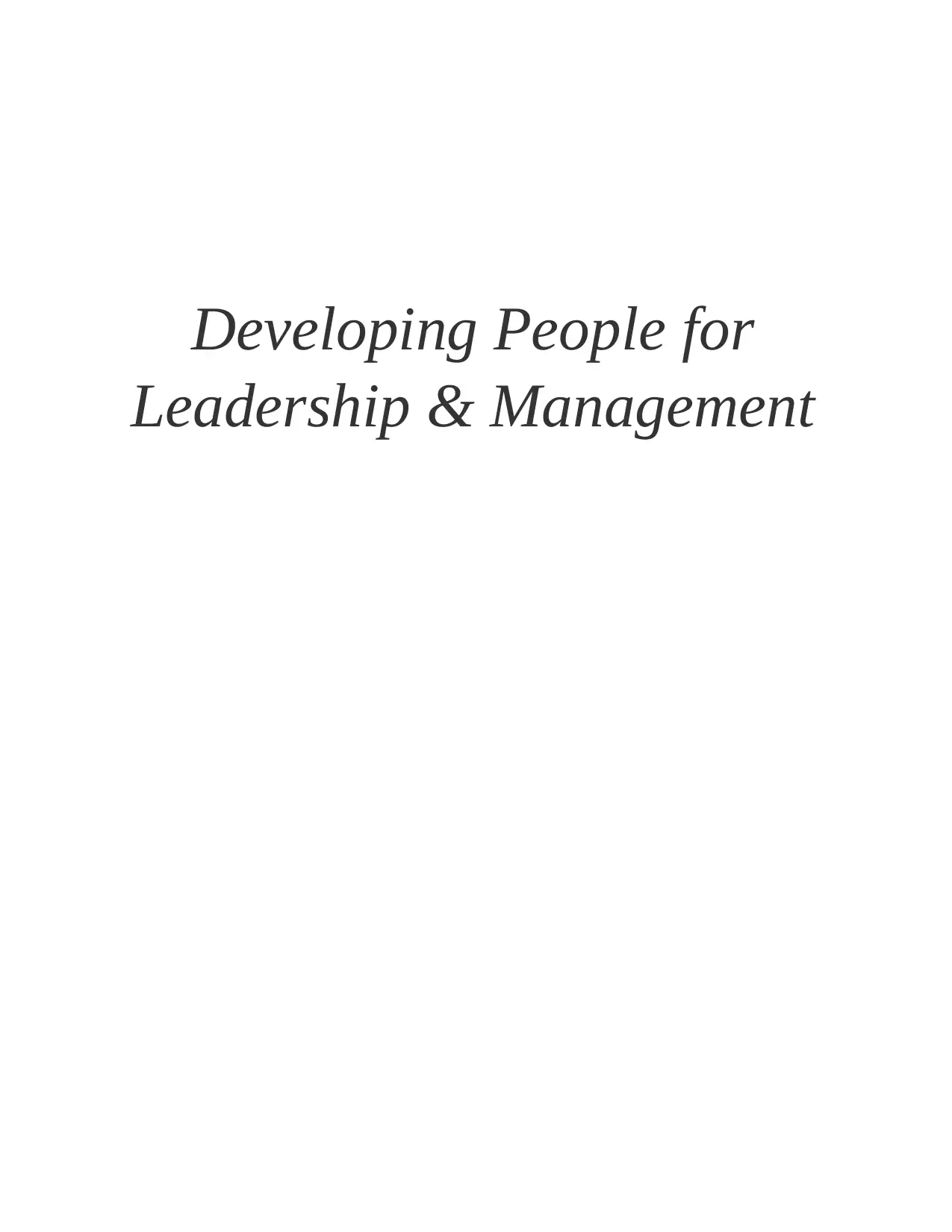
Developing People for
Leadership & Management
Leadership & Management
Paraphrase This Document
Need a fresh take? Get an instant paraphrase of this document with our AI Paraphraser
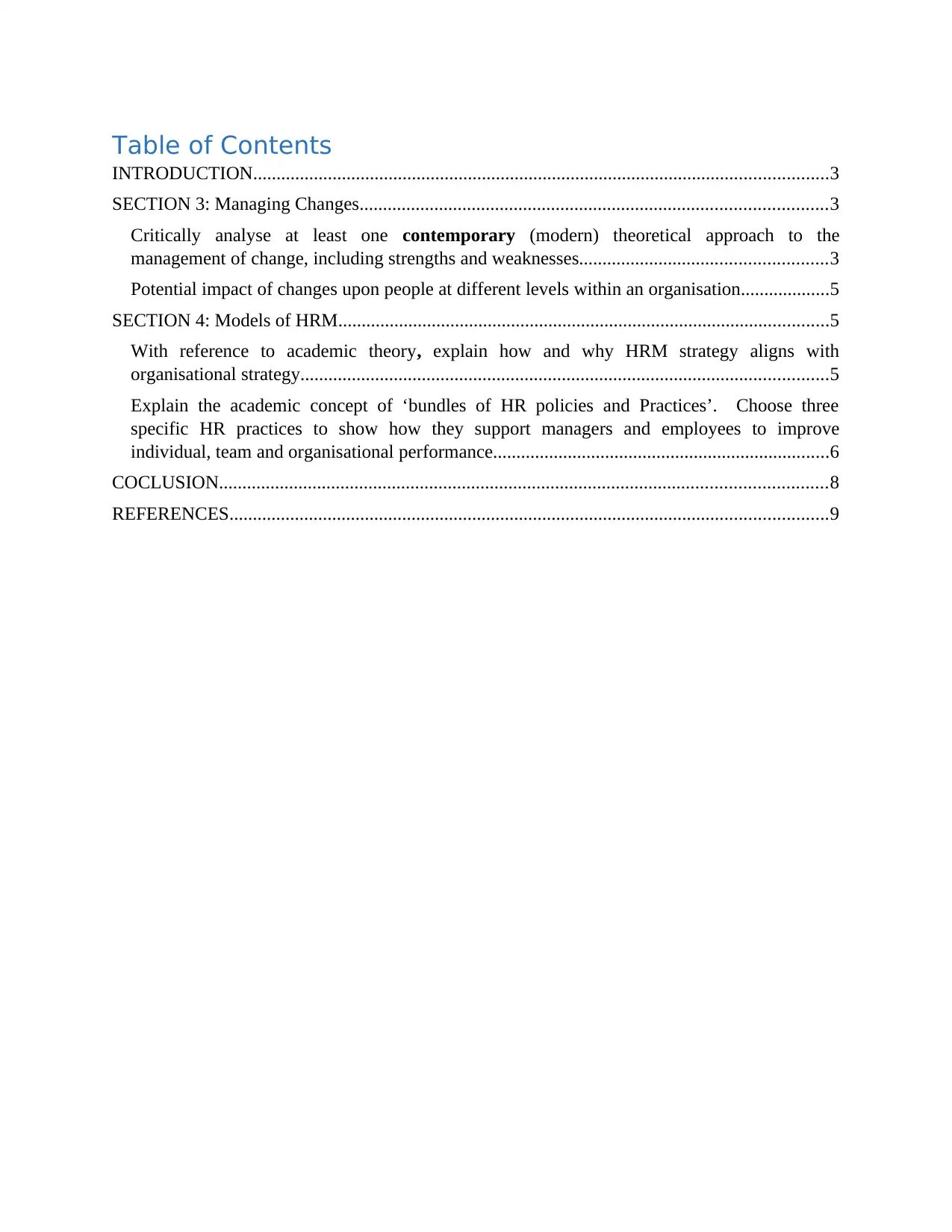
Table of Contents
INTRODUCTION...........................................................................................................................3
SECTION 3: Managing Changes....................................................................................................3
Critically analyse at least one contemporary (modern) theoretical approach to the
management of change, including strengths and weaknesses.....................................................3
Potential impact of changes upon people at different levels within an organisation...................5
SECTION 4: Models of HRM.........................................................................................................5
With reference to academic theory, explain how and why HRM strategy aligns with
organisational strategy.................................................................................................................5
Explain the academic concept of ‘bundles of HR policies and Practices’. Choose three
specific HR practices to show how they support managers and employees to improve
individual, team and organisational performance........................................................................6
COCLUSION..................................................................................................................................8
REFERENCES................................................................................................................................9
INTRODUCTION...........................................................................................................................3
SECTION 3: Managing Changes....................................................................................................3
Critically analyse at least one contemporary (modern) theoretical approach to the
management of change, including strengths and weaknesses.....................................................3
Potential impact of changes upon people at different levels within an organisation...................5
SECTION 4: Models of HRM.........................................................................................................5
With reference to academic theory, explain how and why HRM strategy aligns with
organisational strategy.................................................................................................................5
Explain the academic concept of ‘bundles of HR policies and Practices’. Choose three
specific HR practices to show how they support managers and employees to improve
individual, team and organisational performance........................................................................6
COCLUSION..................................................................................................................................8
REFERENCES................................................................................................................................9
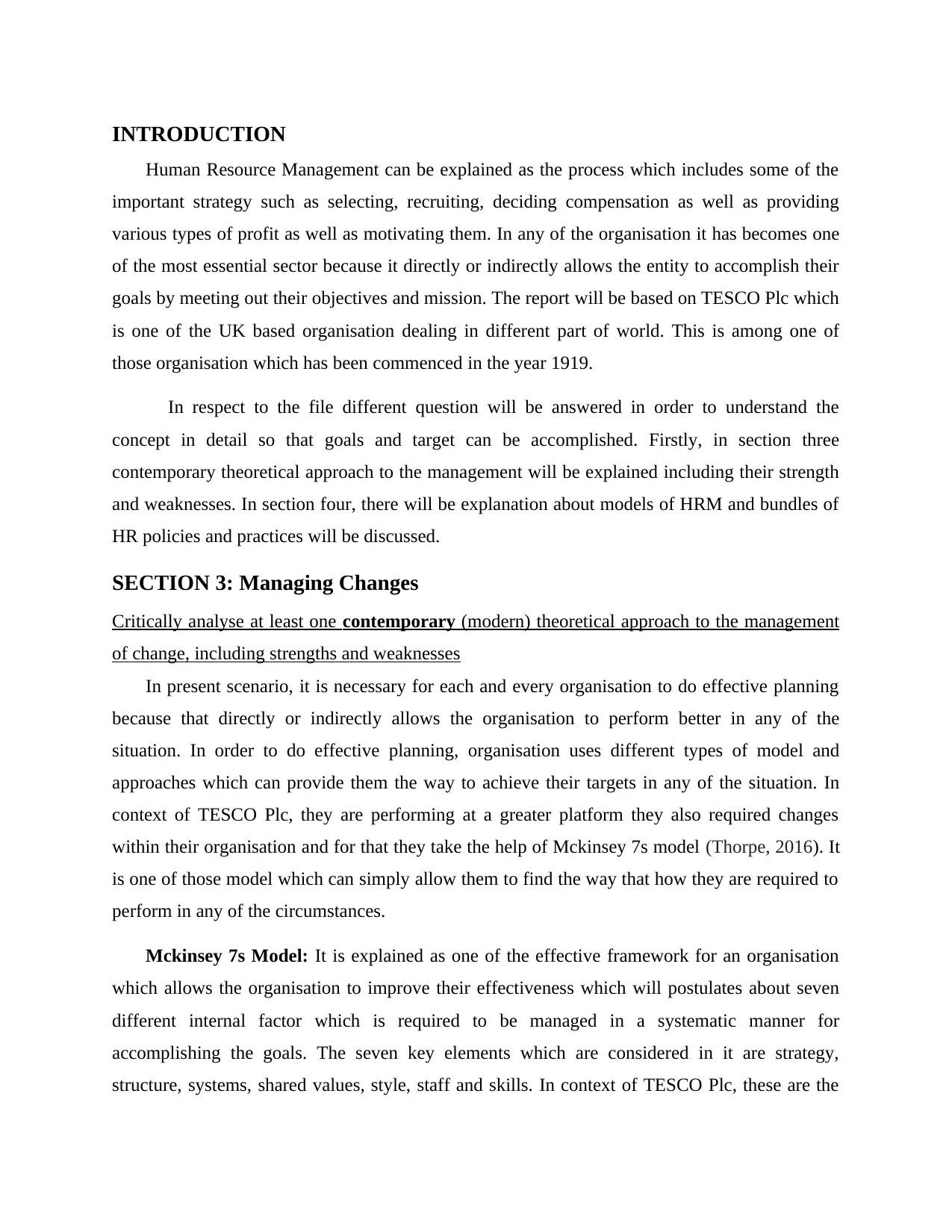
INTRODUCTION
Human Resource Management can be explained as the process which includes some of the
important strategy such as selecting, recruiting, deciding compensation as well as providing
various types of profit as well as motivating them. In any of the organisation it has becomes one
of the most essential sector because it directly or indirectly allows the entity to accomplish their
goals by meeting out their objectives and mission. The report will be based on TESCO Plc which
is one of the UK based organisation dealing in different part of world. This is among one of
those organisation which has been commenced in the year 1919.
In respect to the file different question will be answered in order to understand the
concept in detail so that goals and target can be accomplished. Firstly, in section three
contemporary theoretical approach to the management will be explained including their strength
and weaknesses. In section four, there will be explanation about models of HRM and bundles of
HR policies and practices will be discussed.
SECTION 3: Managing Changes
Critically analyse at least one contemporary (modern) theoretical approach to the management
of change, including strengths and weaknesses
In present scenario, it is necessary for each and every organisation to do effective planning
because that directly or indirectly allows the organisation to perform better in any of the
situation. In order to do effective planning, organisation uses different types of model and
approaches which can provide them the way to achieve their targets in any of the situation. In
context of TESCO Plc, they are performing at a greater platform they also required changes
within their organisation and for that they take the help of Mckinsey 7s model (Thorpe, 2016). It
is one of those model which can simply allow them to find the way that how they are required to
perform in any of the circumstances.
Mckinsey 7s Model: It is explained as one of the effective framework for an organisation
which allows the organisation to improve their effectiveness which will postulates about seven
different internal factor which is required to be managed in a systematic manner for
accomplishing the goals. The seven key elements which are considered in it are strategy,
structure, systems, shared values, style, staff and skills. In context of TESCO Plc, these are the
Human Resource Management can be explained as the process which includes some of the
important strategy such as selecting, recruiting, deciding compensation as well as providing
various types of profit as well as motivating them. In any of the organisation it has becomes one
of the most essential sector because it directly or indirectly allows the entity to accomplish their
goals by meeting out their objectives and mission. The report will be based on TESCO Plc which
is one of the UK based organisation dealing in different part of world. This is among one of
those organisation which has been commenced in the year 1919.
In respect to the file different question will be answered in order to understand the
concept in detail so that goals and target can be accomplished. Firstly, in section three
contemporary theoretical approach to the management will be explained including their strength
and weaknesses. In section four, there will be explanation about models of HRM and bundles of
HR policies and practices will be discussed.
SECTION 3: Managing Changes
Critically analyse at least one contemporary (modern) theoretical approach to the management
of change, including strengths and weaknesses
In present scenario, it is necessary for each and every organisation to do effective planning
because that directly or indirectly allows the organisation to perform better in any of the
situation. In order to do effective planning, organisation uses different types of model and
approaches which can provide them the way to achieve their targets in any of the situation. In
context of TESCO Plc, they are performing at a greater platform they also required changes
within their organisation and for that they take the help of Mckinsey 7s model (Thorpe, 2016). It
is one of those model which can simply allow them to find the way that how they are required to
perform in any of the circumstances.
Mckinsey 7s Model: It is explained as one of the effective framework for an organisation
which allows the organisation to improve their effectiveness which will postulates about seven
different internal factor which is required to be managed in a systematic manner for
accomplishing the goals. The seven key elements which are considered in it are strategy,
structure, systems, shared values, style, staff and skills. In context of TESCO Plc, these are the
⊘ This is a preview!⊘
Do you want full access?
Subscribe today to unlock all pages.

Trusted by 1+ million students worldwide
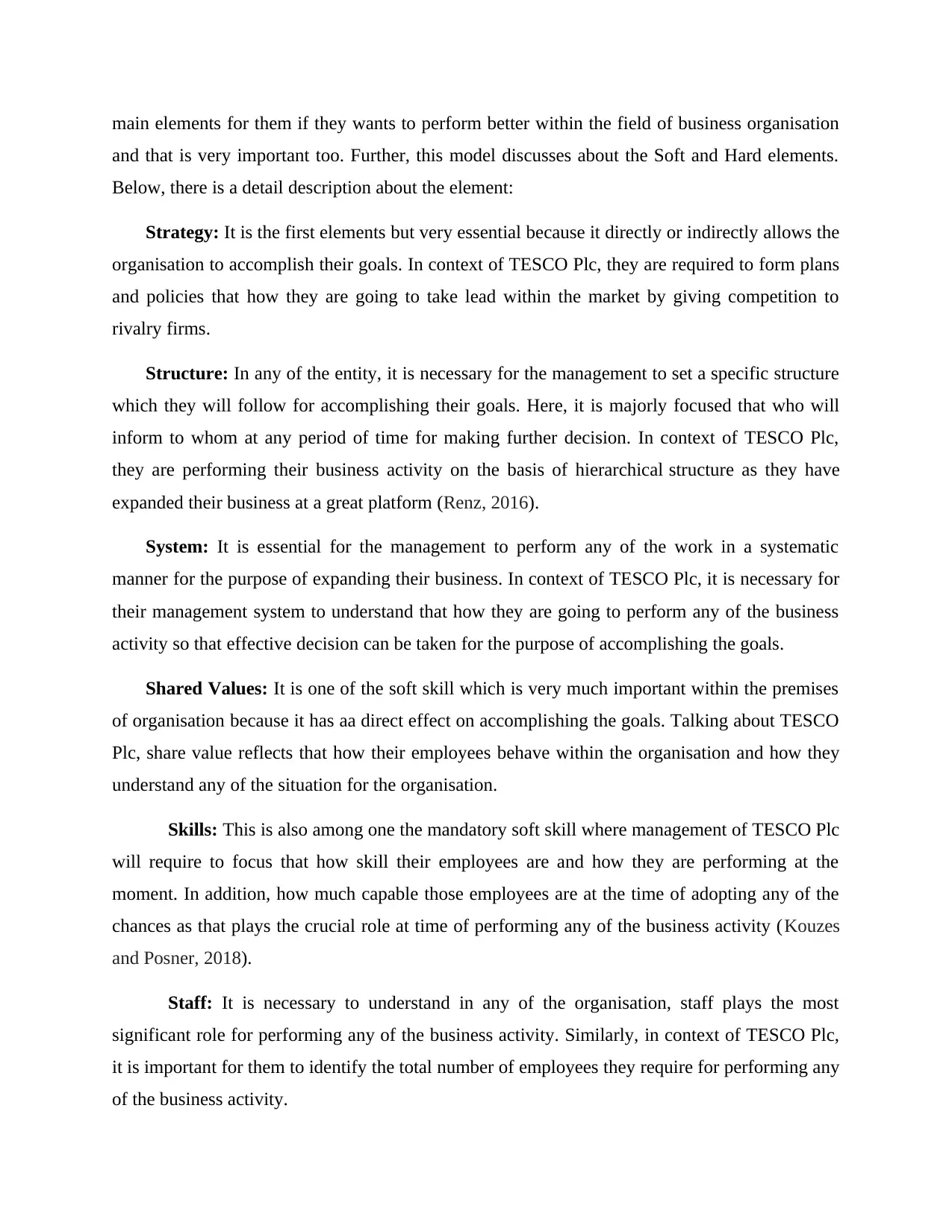
main elements for them if they wants to perform better within the field of business organisation
and that is very important too. Further, this model discusses about the Soft and Hard elements.
Below, there is a detail description about the element:
Strategy: It is the first elements but very essential because it directly or indirectly allows the
organisation to accomplish their goals. In context of TESCO Plc, they are required to form plans
and policies that how they are going to take lead within the market by giving competition to
rivalry firms.
Structure: In any of the entity, it is necessary for the management to set a specific structure
which they will follow for accomplishing their goals. Here, it is majorly focused that who will
inform to whom at any period of time for making further decision. In context of TESCO Plc,
they are performing their business activity on the basis of hierarchical structure as they have
expanded their business at a great platform (Renz, 2016).
System: It is essential for the management to perform any of the work in a systematic
manner for the purpose of expanding their business. In context of TESCO Plc, it is necessary for
their management system to understand that how they are going to perform any of the business
activity so that effective decision can be taken for the purpose of accomplishing the goals.
Shared Values: It is one of the soft skill which is very much important within the premises
of organisation because it has aa direct effect on accomplishing the goals. Talking about TESCO
Plc, share value reflects that how their employees behave within the organisation and how they
understand any of the situation for the organisation.
Skills: This is also among one the mandatory soft skill where management of TESCO Plc
will require to focus that how skill their employees are and how they are performing at the
moment. In addition, how much capable those employees are at the time of adopting any of the
chances as that plays the crucial role at time of performing any of the business activity (Kouzes
and Posner, 2018).
Staff: It is necessary to understand in any of the organisation, staff plays the most
significant role for performing any of the business activity. Similarly, in context of TESCO Plc,
it is important for them to identify the total number of employees they require for performing any
of the business activity.
and that is very important too. Further, this model discusses about the Soft and Hard elements.
Below, there is a detail description about the element:
Strategy: It is the first elements but very essential because it directly or indirectly allows the
organisation to accomplish their goals. In context of TESCO Plc, they are required to form plans
and policies that how they are going to take lead within the market by giving competition to
rivalry firms.
Structure: In any of the entity, it is necessary for the management to set a specific structure
which they will follow for accomplishing their goals. Here, it is majorly focused that who will
inform to whom at any period of time for making further decision. In context of TESCO Plc,
they are performing their business activity on the basis of hierarchical structure as they have
expanded their business at a great platform (Renz, 2016).
System: It is essential for the management to perform any of the work in a systematic
manner for the purpose of expanding their business. In context of TESCO Plc, it is necessary for
their management system to understand that how they are going to perform any of the business
activity so that effective decision can be taken for the purpose of accomplishing the goals.
Shared Values: It is one of the soft skill which is very much important within the premises
of organisation because it has aa direct effect on accomplishing the goals. Talking about TESCO
Plc, share value reflects that how their employees behave within the organisation and how they
understand any of the situation for the organisation.
Skills: This is also among one the mandatory soft skill where management of TESCO Plc
will require to focus that how skill their employees are and how they are performing at the
moment. In addition, how much capable those employees are at the time of adopting any of the
chances as that plays the crucial role at time of performing any of the business activity (Kouzes
and Posner, 2018).
Staff: It is necessary to understand in any of the organisation, staff plays the most
significant role for performing any of the business activity. Similarly, in context of TESCO Plc,
it is important for them to identify the total number of employees they require for performing any
of the business activity.
Paraphrase This Document
Need a fresh take? Get an instant paraphrase of this document with our AI Paraphraser
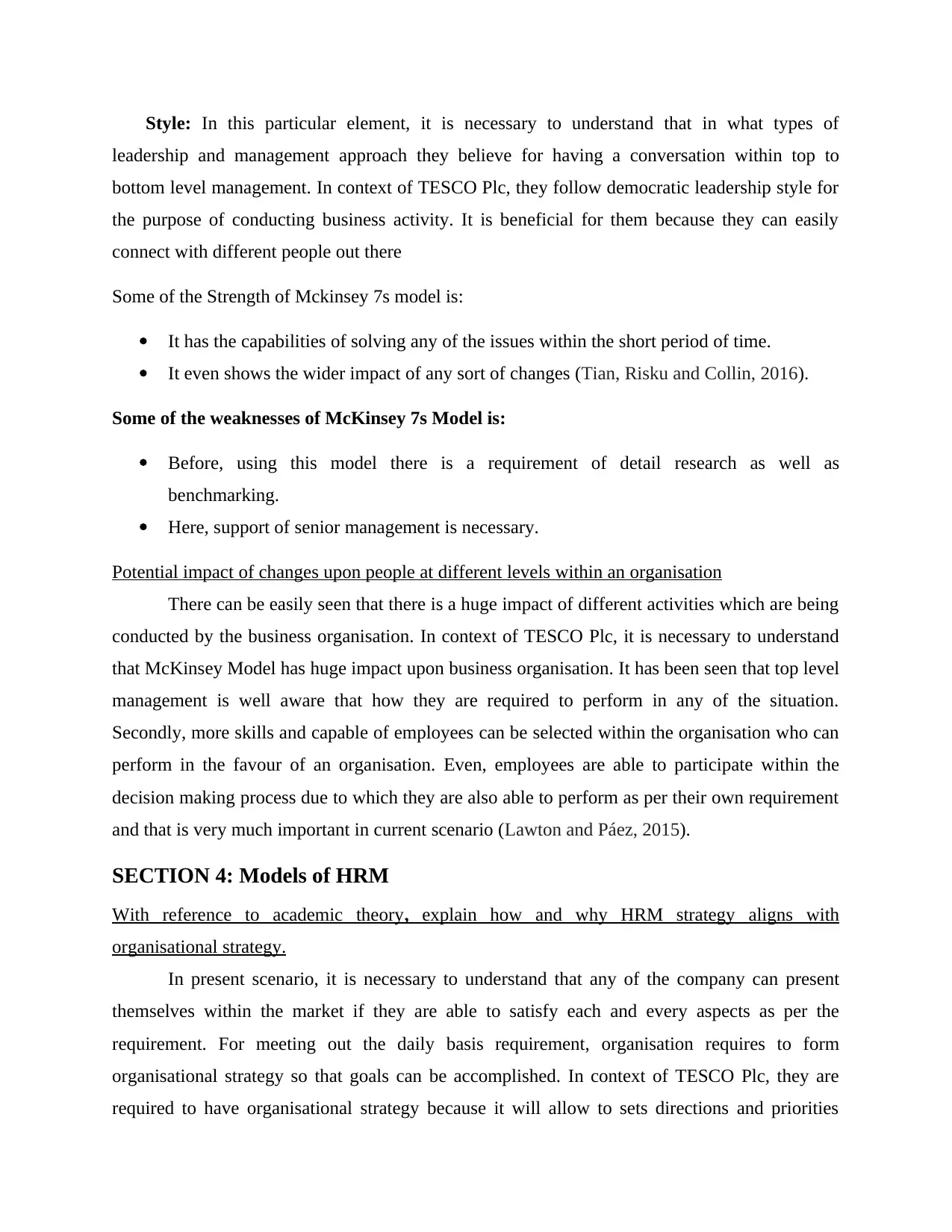
Style: In this particular element, it is necessary to understand that in what types of
leadership and management approach they believe for having a conversation within top to
bottom level management. In context of TESCO Plc, they follow democratic leadership style for
the purpose of conducting business activity. It is beneficial for them because they can easily
connect with different people out there
Some of the Strength of Mckinsey 7s model is:
It has the capabilities of solving any of the issues within the short period of time.
It even shows the wider impact of any sort of changes (Tian, Risku and Collin, 2016).
Some of the weaknesses of McKinsey 7s Model is:
Before, using this model there is a requirement of detail research as well as
benchmarking.
Here, support of senior management is necessary.
Potential impact of changes upon people at different levels within an organisation
There can be easily seen that there is a huge impact of different activities which are being
conducted by the business organisation. In context of TESCO Plc, it is necessary to understand
that McKinsey Model has huge impact upon business organisation. It has been seen that top level
management is well aware that how they are required to perform in any of the situation.
Secondly, more skills and capable of employees can be selected within the organisation who can
perform in the favour of an organisation. Even, employees are able to participate within the
decision making process due to which they are also able to perform as per their own requirement
and that is very much important in current scenario (Lawton and Páez, 2015).
SECTION 4: Models of HRM
With reference to academic theory, explain how and why HRM strategy aligns with
organisational strategy.
In present scenario, it is necessary to understand that any of the company can present
themselves within the market if they are able to satisfy each and every aspects as per the
requirement. For meeting out the daily basis requirement, organisation requires to form
organisational strategy so that goals can be accomplished. In context of TESCO Plc, they are
required to have organisational strategy because it will allow to sets directions and priorities
leadership and management approach they believe for having a conversation within top to
bottom level management. In context of TESCO Plc, they follow democratic leadership style for
the purpose of conducting business activity. It is beneficial for them because they can easily
connect with different people out there
Some of the Strength of Mckinsey 7s model is:
It has the capabilities of solving any of the issues within the short period of time.
It even shows the wider impact of any sort of changes (Tian, Risku and Collin, 2016).
Some of the weaknesses of McKinsey 7s Model is:
Before, using this model there is a requirement of detail research as well as
benchmarking.
Here, support of senior management is necessary.
Potential impact of changes upon people at different levels within an organisation
There can be easily seen that there is a huge impact of different activities which are being
conducted by the business organisation. In context of TESCO Plc, it is necessary to understand
that McKinsey Model has huge impact upon business organisation. It has been seen that top level
management is well aware that how they are required to perform in any of the situation.
Secondly, more skills and capable of employees can be selected within the organisation who can
perform in the favour of an organisation. Even, employees are able to participate within the
decision making process due to which they are also able to perform as per their own requirement
and that is very much important in current scenario (Lawton and Páez, 2015).
SECTION 4: Models of HRM
With reference to academic theory, explain how and why HRM strategy aligns with
organisational strategy.
In present scenario, it is necessary to understand that any of the company can present
themselves within the market if they are able to satisfy each and every aspects as per the
requirement. For meeting out the daily basis requirement, organisation requires to form
organisational strategy so that goals can be accomplished. In context of TESCO Plc, they are
required to have organisational strategy because it will allow to sets directions and priorities
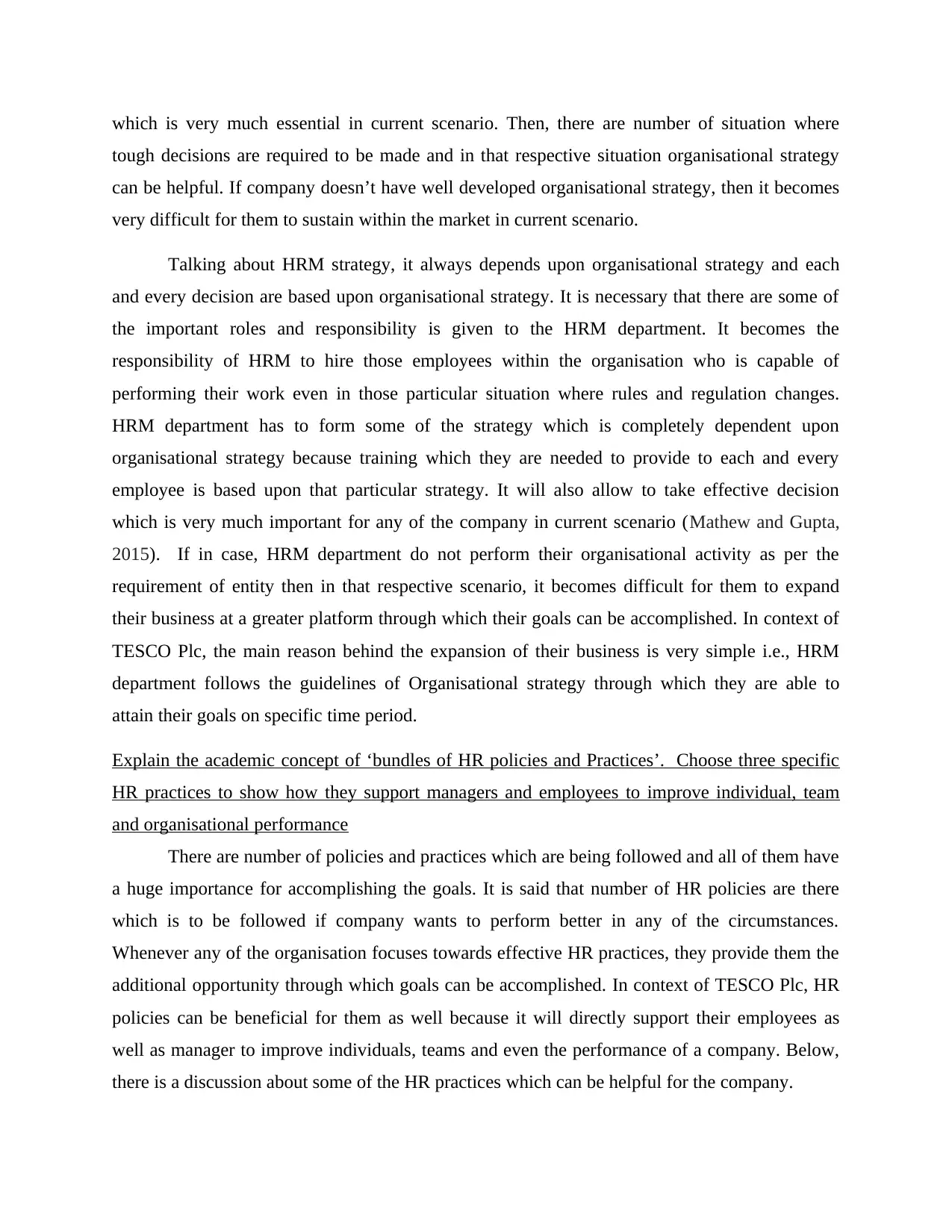
which is very much essential in current scenario. Then, there are number of situation where
tough decisions are required to be made and in that respective situation organisational strategy
can be helpful. If company doesn’t have well developed organisational strategy, then it becomes
very difficult for them to sustain within the market in current scenario.
Talking about HRM strategy, it always depends upon organisational strategy and each
and every decision are based upon organisational strategy. It is necessary that there are some of
the important roles and responsibility is given to the HRM department. It becomes the
responsibility of HRM to hire those employees within the organisation who is capable of
performing their work even in those particular situation where rules and regulation changes.
HRM department has to form some of the strategy which is completely dependent upon
organisational strategy because training which they are needed to provide to each and every
employee is based upon that particular strategy. It will also allow to take effective decision
which is very much important for any of the company in current scenario (Mathew and Gupta,
2015). If in case, HRM department do not perform their organisational activity as per the
requirement of entity then in that respective scenario, it becomes difficult for them to expand
their business at a greater platform through which their goals can be accomplished. In context of
TESCO Plc, the main reason behind the expansion of their business is very simple i.e., HRM
department follows the guidelines of Organisational strategy through which they are able to
attain their goals on specific time period.
Explain the academic concept of ‘bundles of HR policies and Practices’. Choose three specific
HR practices to show how they support managers and employees to improve individual, team
and organisational performance
There are number of policies and practices which are being followed and all of them have
a huge importance for accomplishing the goals. It is said that number of HR policies are there
which is to be followed if company wants to perform better in any of the circumstances.
Whenever any of the organisation focuses towards effective HR practices, they provide them the
additional opportunity through which goals can be accomplished. In context of TESCO Plc, HR
policies can be beneficial for them as well because it will directly support their employees as
well as manager to improve individuals, teams and even the performance of a company. Below,
there is a discussion about some of the HR practices which can be helpful for the company.
tough decisions are required to be made and in that respective situation organisational strategy
can be helpful. If company doesn’t have well developed organisational strategy, then it becomes
very difficult for them to sustain within the market in current scenario.
Talking about HRM strategy, it always depends upon organisational strategy and each
and every decision are based upon organisational strategy. It is necessary that there are some of
the important roles and responsibility is given to the HRM department. It becomes the
responsibility of HRM to hire those employees within the organisation who is capable of
performing their work even in those particular situation where rules and regulation changes.
HRM department has to form some of the strategy which is completely dependent upon
organisational strategy because training which they are needed to provide to each and every
employee is based upon that particular strategy. It will also allow to take effective decision
which is very much important for any of the company in current scenario (Mathew and Gupta,
2015). If in case, HRM department do not perform their organisational activity as per the
requirement of entity then in that respective scenario, it becomes difficult for them to expand
their business at a greater platform through which their goals can be accomplished. In context of
TESCO Plc, the main reason behind the expansion of their business is very simple i.e., HRM
department follows the guidelines of Organisational strategy through which they are able to
attain their goals on specific time period.
Explain the academic concept of ‘bundles of HR policies and Practices’. Choose three specific
HR practices to show how they support managers and employees to improve individual, team
and organisational performance
There are number of policies and practices which are being followed and all of them have
a huge importance for accomplishing the goals. It is said that number of HR policies are there
which is to be followed if company wants to perform better in any of the circumstances.
Whenever any of the organisation focuses towards effective HR practices, they provide them the
additional opportunity through which goals can be accomplished. In context of TESCO Plc, HR
policies can be beneficial for them as well because it will directly support their employees as
well as manager to improve individuals, teams and even the performance of a company. Below,
there is a discussion about some of the HR practices which can be helpful for the company.
⊘ This is a preview!⊘
Do you want full access?
Subscribe today to unlock all pages.

Trusted by 1+ million students worldwide
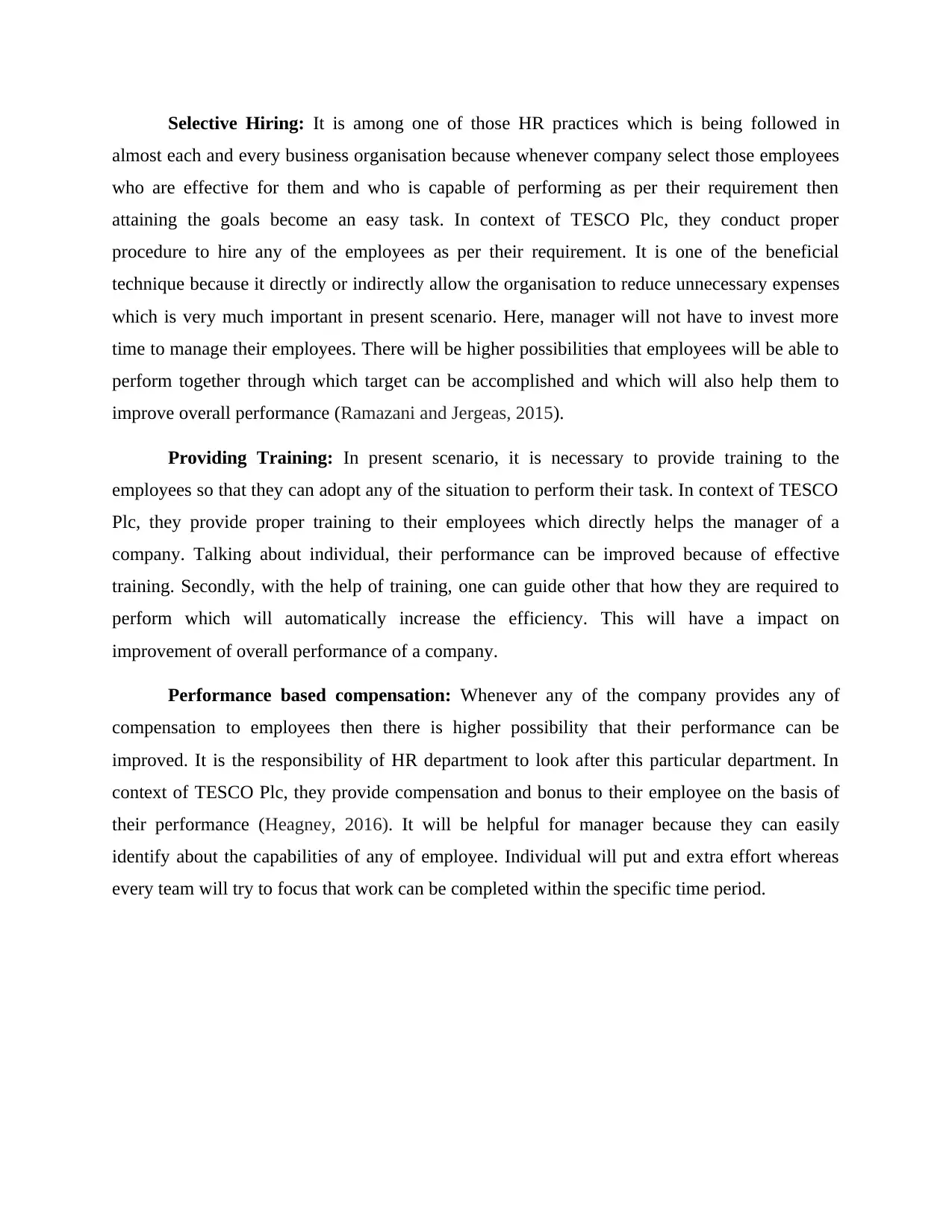
Selective Hiring: It is among one of those HR practices which is being followed in
almost each and every business organisation because whenever company select those employees
who are effective for them and who is capable of performing as per their requirement then
attaining the goals become an easy task. In context of TESCO Plc, they conduct proper
procedure to hire any of the employees as per their requirement. It is one of the beneficial
technique because it directly or indirectly allow the organisation to reduce unnecessary expenses
which is very much important in present scenario. Here, manager will not have to invest more
time to manage their employees. There will be higher possibilities that employees will be able to
perform together through which target can be accomplished and which will also help them to
improve overall performance (Ramazani and Jergeas, 2015).
Providing Training: In present scenario, it is necessary to provide training to the
employees so that they can adopt any of the situation to perform their task. In context of TESCO
Plc, they provide proper training to their employees which directly helps the manager of a
company. Talking about individual, their performance can be improved because of effective
training. Secondly, with the help of training, one can guide other that how they are required to
perform which will automatically increase the efficiency. This will have a impact on
improvement of overall performance of a company.
Performance based compensation: Whenever any of the company provides any of
compensation to employees then there is higher possibility that their performance can be
improved. It is the responsibility of HR department to look after this particular department. In
context of TESCO Plc, they provide compensation and bonus to their employee on the basis of
their performance (Heagney, 2016). It will be helpful for manager because they can easily
identify about the capabilities of any of employee. Individual will put and extra effort whereas
every team will try to focus that work can be completed within the specific time period.
almost each and every business organisation because whenever company select those employees
who are effective for them and who is capable of performing as per their requirement then
attaining the goals become an easy task. In context of TESCO Plc, they conduct proper
procedure to hire any of the employees as per their requirement. It is one of the beneficial
technique because it directly or indirectly allow the organisation to reduce unnecessary expenses
which is very much important in present scenario. Here, manager will not have to invest more
time to manage their employees. There will be higher possibilities that employees will be able to
perform together through which target can be accomplished and which will also help them to
improve overall performance (Ramazani and Jergeas, 2015).
Providing Training: In present scenario, it is necessary to provide training to the
employees so that they can adopt any of the situation to perform their task. In context of TESCO
Plc, they provide proper training to their employees which directly helps the manager of a
company. Talking about individual, their performance can be improved because of effective
training. Secondly, with the help of training, one can guide other that how they are required to
perform which will automatically increase the efficiency. This will have a impact on
improvement of overall performance of a company.
Performance based compensation: Whenever any of the company provides any of
compensation to employees then there is higher possibility that their performance can be
improved. It is the responsibility of HR department to look after this particular department. In
context of TESCO Plc, they provide compensation and bonus to their employee on the basis of
their performance (Heagney, 2016). It will be helpful for manager because they can easily
identify about the capabilities of any of employee. Individual will put and extra effort whereas
every team will try to focus that work can be completed within the specific time period.
Paraphrase This Document
Need a fresh take? Get an instant paraphrase of this document with our AI Paraphraser

COCLUSION
From the above discussion, it can be concluded that managing changes within the
organisation is very important because it directly reflects that how well company is able to adopt
changes for attaining their targets. It is crucial for the business organisation to understand that
HRM department has a huge role within the company but they are needed to ensure that they will
be able to take each and every decision as per the organisational strategy. Also, different form of
HRM practices are important because it certainly uplifts the performance through which chances
of obtaining the increases automatically.
From the above discussion, it can be concluded that managing changes within the
organisation is very important because it directly reflects that how well company is able to adopt
changes for attaining their targets. It is crucial for the business organisation to understand that
HRM department has a huge role within the company but they are needed to ensure that they will
be able to take each and every decision as per the organisational strategy. Also, different form of
HRM practices are important because it certainly uplifts the performance through which chances
of obtaining the increases automatically.
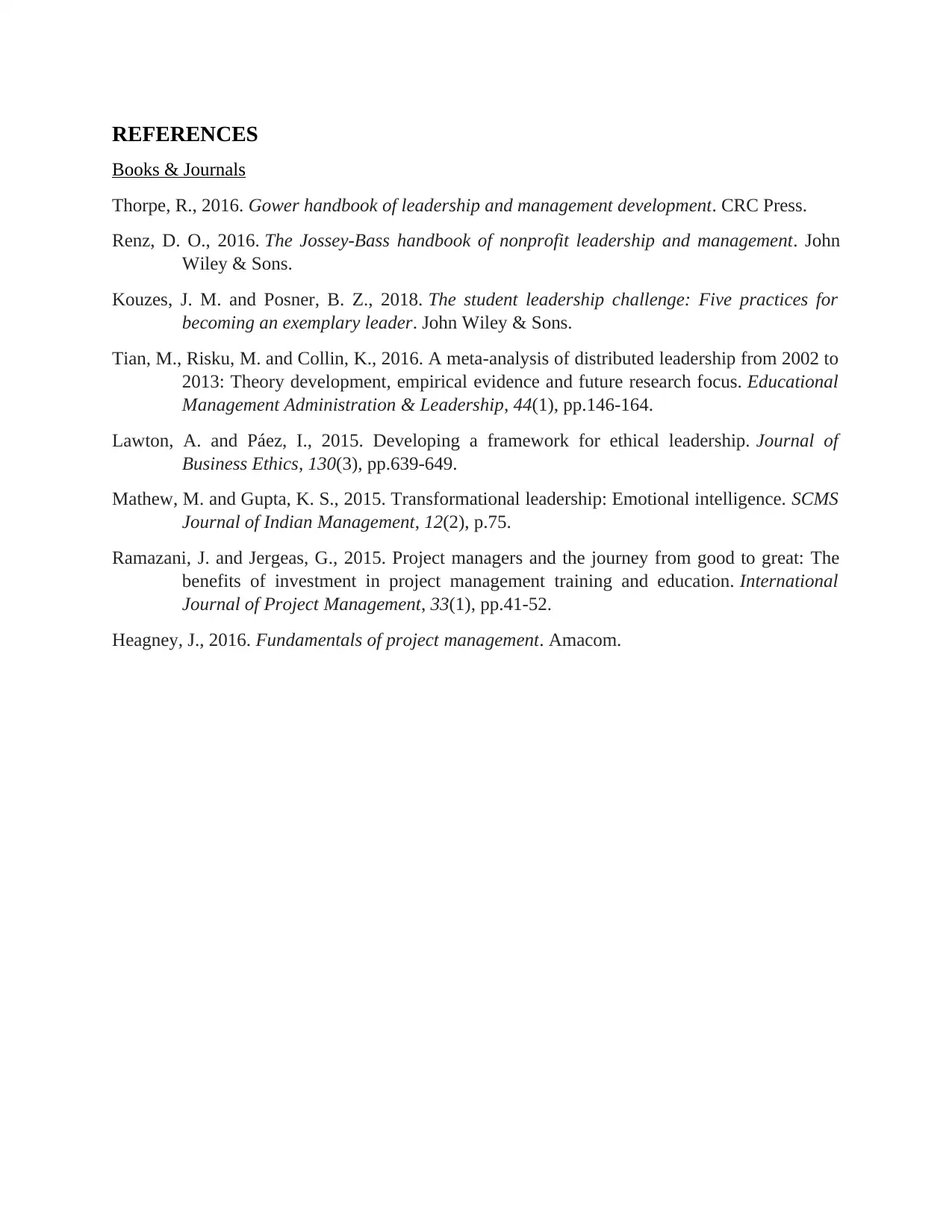
REFERENCES
Books & Journals
Thorpe, R., 2016. Gower handbook of leadership and management development. CRC Press.
Renz, D. O., 2016. The Jossey-Bass handbook of nonprofit leadership and management. John
Wiley & Sons.
Kouzes, J. M. and Posner, B. Z., 2018. The student leadership challenge: Five practices for
becoming an exemplary leader. John Wiley & Sons.
Tian, M., Risku, M. and Collin, K., 2016. A meta-analysis of distributed leadership from 2002 to
2013: Theory development, empirical evidence and future research focus. Educational
Management Administration & Leadership, 44(1), pp.146-164.
Lawton, A. and Páez, I., 2015. Developing a framework for ethical leadership. Journal of
Business Ethics, 130(3), pp.639-649.
Mathew, M. and Gupta, K. S., 2015. Transformational leadership: Emotional intelligence. SCMS
Journal of Indian Management, 12(2), p.75.
Ramazani, J. and Jergeas, G., 2015. Project managers and the journey from good to great: The
benefits of investment in project management training and education. International
Journal of Project Management, 33(1), pp.41-52.
Heagney, J., 2016. Fundamentals of project management. Amacom.
Books & Journals
Thorpe, R., 2016. Gower handbook of leadership and management development. CRC Press.
Renz, D. O., 2016. The Jossey-Bass handbook of nonprofit leadership and management. John
Wiley & Sons.
Kouzes, J. M. and Posner, B. Z., 2018. The student leadership challenge: Five practices for
becoming an exemplary leader. John Wiley & Sons.
Tian, M., Risku, M. and Collin, K., 2016. A meta-analysis of distributed leadership from 2002 to
2013: Theory development, empirical evidence and future research focus. Educational
Management Administration & Leadership, 44(1), pp.146-164.
Lawton, A. and Páez, I., 2015. Developing a framework for ethical leadership. Journal of
Business Ethics, 130(3), pp.639-649.
Mathew, M. and Gupta, K. S., 2015. Transformational leadership: Emotional intelligence. SCMS
Journal of Indian Management, 12(2), p.75.
Ramazani, J. and Jergeas, G., 2015. Project managers and the journey from good to great: The
benefits of investment in project management training and education. International
Journal of Project Management, 33(1), pp.41-52.
Heagney, J., 2016. Fundamentals of project management. Amacom.
⊘ This is a preview!⊘
Do you want full access?
Subscribe today to unlock all pages.

Trusted by 1+ million students worldwide
1 out of 9
Related Documents
Your All-in-One AI-Powered Toolkit for Academic Success.
+13062052269
info@desklib.com
Available 24*7 on WhatsApp / Email
![[object Object]](/_next/static/media/star-bottom.7253800d.svg)
Unlock your academic potential
Copyright © 2020–2025 A2Z Services. All Rights Reserved. Developed and managed by ZUCOL.





